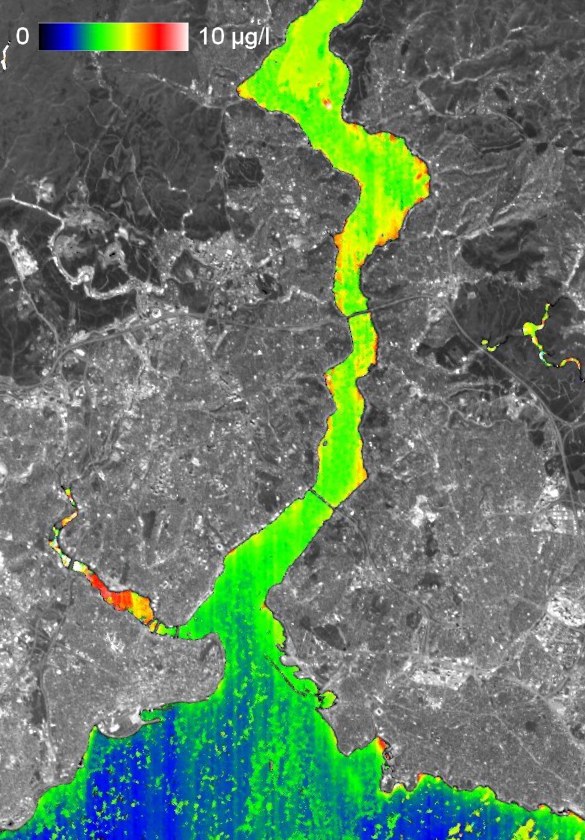German EnMAP environmental satellite delivers first images



- The German Environmental Mapping and Analysis Program (EnMAP) satellite has delivered its first images, one month after launch.
- The mission is managed by the German Space Agency at DLR in Bonn on behalf of the German Federal Ministry for Economic Affairs and Climate Action (BMWK).
- OHB System AG was contracted to develop and build the satellite and the hyperspectral instruments. The German Research Centre for Geosciences (GeoForschungsZentrum; GFZ) in Potsdam is the scientific lead for the mission.
- Focus: Space, Earth observation, climate change, environmental protection and nature conservation
The German Environmental Mapping and Analysis Program (EnMAP) satellite, which is managed by the German Space Agency at the German Aerospace Center (Deutsches Zentrum für Luft- und Raumfahrt; DLR) in Bonn on behalf of the Federal Ministry for Economic Affairs and Climate Action (BMWK), has spent roughly one month in space since its launch on 1 April 2022. It has now delivered its first high-resolution satellite images. Following the successful completion of the mission’s Launch and Early Orbit Phase, the individual subsystems of the highly complex hyperspectral instrument were put into operation piece by piece under the control of the German Space Operations Center (GSOC). EnMAP has now imaged a strip approximately 30 kilometres wide and 180 kilometres long over Istanbul on the Bosporus, Turkey, where Europe meets Asia and sent the data down to Earth via the DLR ground station in Neustrelitz.
"The first data from EnMAP have demonstrated what the German environmental satellite is capable of," says a delighted Sebastian Fischer, EnMAP Project Manager at the German Space Agency at DLR. The mission is still in its first phase, in which the hyperspectral instrument is being calibrated and precisely adjusted. "But these first images already give us a very good idea of what researchers around the world can expect. They show that EnMAP can make a major contribution to highlighting the consequences of climate change and counteracting the ongoing destruction of the environment."

The first images from the EnMAP environmental satellite
Your consent to the storage of data ('cookies') is required for the playback of this video on Youtube.com. You can view and change your current data storage settings at any time under privacy.
Deutsche Raumfahrtagentur im DLR
The first data were received by the German Remote Sensing Data Center (DFD) and the DLR Remote Sensing Technology Institute, which also process and archive the images. The data that the satellite sends to Earth cannot be utilised directly by end users. Only when they are further processed – when they are calibrated, provided with position and attitude data and the influences of the atmosphere are corrected – can users draw quantitative and qualitative conclusions from the products. The calibration of these first images was carried out using data measured by the instrument in the laboratory as a reference. During the commissioning phase, which lasts six months, these calibrations will be optimised for the characteristics of the instrument in orbit and the data quality will be further improved.
First EnMAP images make the invisible visible to our eyes
But what can we actually see in the EnMAP images? Every material on Earth's surface reflects sunlight in a characteristic way, leaving behind a spectral signature. EnMAP can recognise, distinguish and image this 'colour fingerprint' with the help of its measuring instrument. Thus, the mission's motto is 'Our Earth in more than just colour', because each EnMAP image is divided into a great many small wavelength ranges – many more than our eyes can perceive. "The high quality of the data in all channels is clearly visible in typical spectra, such as for vegetation, and in low noise and disturbing image stripes in the extensive dynamic range, which is particularly evident in dark areas such as water. Based on this initial data, researchers at the DLR Earth Observation Center (EOC) were already able to derive preliminary results on the distribution of 'chlorophyll a' concentration at the water surface after atmospheric correction and by means of inverse modelling," adds Tobias Storch, Project Manager of the EnMAP ground segment at the EOC.
EnMAP – the German environmental mission and its partners
The EnMAP mission is being managed by the German Space Agency at the German Aerospace Center (Deutsches Zentrum für Luft- und Raumfahrt; DLR) in Bonn on behalf of the Federal Ministry for Economic Affairs and Climate Action (Bundesministerium für Wirtschaft und Klimaschutz; BMWK). OHB System AG was contracted to develop and build the satellite and the hyperspectral instruments. The German Research Centre for Geosciences (GeoForschungsZentrum; GFZ) in Potsdam is the science Principal Investigator for the mission.
Three DLR institutes and facilities have been commissioned for the construction and operation of the ground segment. The German Space Operations Center in Oberpfaffenhofen will conduct and monitor satellite operations, while the German Remote Sensing Data Center and the DLR Remote Sensing Technology Institute will archive, process and validate the received satellite data and make them available to the scientific community. Companies and public authorities will also test the data and use them to prepare future services. The use of EnMAP hyperspectral data by universities and scientific institutions and the development of special applications will be supported by BMWK funding programmes.
